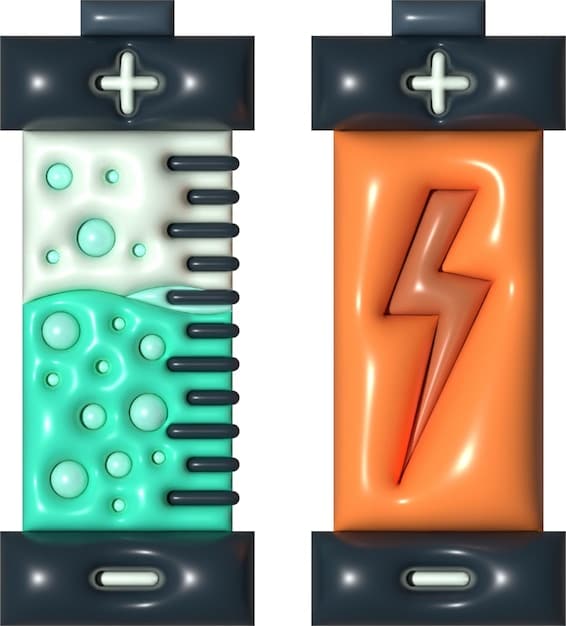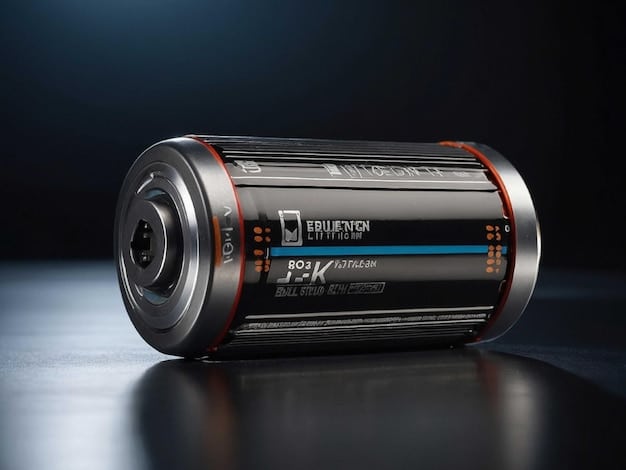New Battery Technology for US Electric Vehicles: Advancements & Innovations

Advancements in battery technology for electric vehicles (EVs) in the US include innovations like solid-state batteries, lithium-sulfur batteries, silicon anodes, and improved battery management systems, all aimed at increasing energy density, range, safety, and lifespan.
The electric vehicle (EV) market in the United States is rapidly evolving, and at the heart of this transformation lies battery technology. The quest for longer ranges, faster charging times, and improved safety has spurred significant innovation in recent years. Let’s delve into what are the new advancements in battery technology for electric vehicles in the US.
Understanding the Current Landscape of EV Batteries
Electric vehicle batteries have come a long way since the first EVs hit the roads. Currently, lithium-ion batteries dominate the market, offering a good balance of energy density, power, and lifespan. However, ongoing research and development are pushing the boundaries of what’s possible. This section explores the foundational aspects of today’s EV batteries before diving into the advancements.
Lithium-Ion Batteries: The Current Standard
Lithium-ion batteries are favored for their relatively high energy density and long cycle life. They function by shuttling lithium ions between a positive electrode (cathode) and a negative electrode (anode) through an electrolyte.
Limitations of Current Batteries
Despite their prevalence, lithium-ion batteries have certain limitations. These include thermal instability (risk of overheating and fire), limited energy density compared to theoretical limits, and the use of conflict minerals like cobalt.
- Energy Density: Current lithium-ion batteries offer a limited range for EVs, pushing the need for batteries with higher energy density.
- Charging Time: Prolonged charging times remain a hurdle for EV adoption, spurring research into faster charging technologies.
- Safety Concerns: Thermal runaway and the risk of fires associated with lithium-ion batteries are major safety concerns.
- Cost: The high cost of battery packs significantly contributes to the overall price of EVs.
The current state of EV battery technology, while advanced, is not without its shortcomings. These limitations are driving the development of new and improved battery technologies aimed at overcoming these challenges. The next generation of batteries promises to revolutionize the EV industry by providing improvements in range, safety, and cost.

Solid-State Batteries: A Game Changer?
Solid-state batteries are emerging as a potential game-changer in the EV industry. Unlike conventional lithium-ion batteries that use a liquid electrolyte, solid-state batteries employ a solid electrolyte, offering numerous advantages.
What are Solid-State Batteries?
Solid-state batteries replace the flammable liquid electrolyte with a solid material, enhancing safety and enabling the use of higher energy density electrode materials. This technology promises to mitigate the risk of thermal runaway and fires.
Advantages of Solid-State Batteries
Solid-state batteries have significant benefits, including increased safety, higher energy density, faster charging, and longer lifespan.
- Enhanced Safety: The non-flammable solid electrolyte significantly reduces the risk of fires.
- Higher Energy Density: Solid-state electrolytes allow for the use of lithium metal anodes, which can dramatically increase energy density.
- Faster Charging: Improved ionic conductivity in some solid electrolytes enables faster charging times.
- Longer Lifespan: Solid-state batteries are expected to have a longer lifespan and better cycle stability.
Solid-state technology is poised to solve many of the issues associated with current lithium-ion batteries. Several companies, including QuantumScape and Solid Power, are actively developing solid-state batteries for EVs. While challenges remain in terms of scalability and cost, the potential benefits are substantial. This positions solid-state batteries as a strong contender for the future of EV energy storage. In the US, companies and research institutions are vigorously pursuing solid-state battery advancements, aiming to capture a significant portion of the evolving EV battery market.

Lithium-Sulfur Batteries: A Cost-Effective Alternative
Lithium-sulfur (Li-S) batteries are garnering attention as a potentially cost-effective alternative to lithium-ion and solid-state batteries. These batteries use sulfur as the cathode material, which is abundant and inexpensive, offering considerable cost benefits.
The Potential of Lithium-Sulfur
Lithium-sulfur batteries promise higher energy density and lower cost compared to lithium-ion batteries. Sulfur is a lightweight material, contributing to the higher energy-to-weight ratio of Li-S batteries.
Challenges and Solutions
Despite their promise, lithium-sulfur batteries face challenges, mainly related to the dissolution of polysulfides (intermediate reaction products) into the electrolyte, leading to capacity fade.
- Polysulfide Shuttle Effect: The dissolution of polysulfides results in a loss of sulfur from the cathode, reducing battery capacity.
- Low Conductivity of Sulfur: Sulfur has poor electrical conductivity, which limits the battery’s performance.
- Volume Expansion: Sulfur experiences significant volume expansion during discharge, leading to structural instability.
Researchers are actively working on solutions to these challenges, including novel electrolyte additives, advanced cathode architectures, and protective coatings. These improvements aim to trap polysulfides, enhance sulfur conductivity, and accommodate volume changes during cycling. Companies and research institutions in the US are particularly focused on overcoming these challenges. If successful, lithium-sulfur batteries could significantly reduce the cost of EVs, making them more accessible to a broader consumer base. This would represent a major step forward in the widespread adoption of electric vehicles.
Silicon Anodes: Boosting Energy Density
Another promising area of advancement in EV battery technology is the use of silicon anodes. Silicon has a much higher theoretical lithium-ion storage capacity compared to the graphite currently used in most lithium-ion batteries.
Advantages of Silicon Anodes
Silicon anodes can significantly increase the energy density of lithium-ion batteries. This translates to longer driving ranges for EVs without increasing the size or weight of the battery pack.
Overcoming Silicon’s Challenges
Silicon anodes exhibit large volume changes during charging and discharging, leading to cracking and capacity fade. Researchers are exploring various strategies to mitigate this issue.
- Nanostructured Silicon: Using silicon in the form of nanowires, nanoparticles, or porous structures can accommodate volume changes.
- Silicon Composites: Combining silicon with other materials like carbon can improve the mechanical stability and conductivity of the anode.
- Advanced Binders: Developing binders that can better withstand the volume changes of silicon is crucial for maintaining electrode integrity.
Companies like Sila Nanotechnologies are making significant strides in developing silicon anode materials. Their advancements have led to improved battery performance and durability. Successfully integrating silicon anodes into commercial EV batteries could substantially improve their energy density and range. The development of silicon anodes represents a key pathway to enhance the performance of electric vehicles in the US market. Such innovations are vital in meeting the growing demand for EVs that offer both extended range and reliable performance.
Battery Management Systems (BMS): Enhancing Performance and Safety
Battery Management Systems (BMS) are essential components of EV batteries, responsible for monitoring and controlling battery performance, safety, and lifespan. These systems have also seen considerable advancements in recent years.
The Role of BMS
A BMS monitors parameters such as voltage, current, temperature, and state of charge of individual battery cells. It also implements control strategies to optimize battery performance and prevent damage.
Advanced BMS Features
Modern BMS incorporate advanced features such as cell balancing, thermal management, and predictive algorithms. These features contribute to improved battery lifespan, enhanced safety, and optimized energy utilization.
Cell balancing ensures that all cells in the battery pack are at the same state of charge, preventing overcharging or over-discharging of individual cells.
- Thermal Management: Advanced cooling systems and thermal management algorithms maintain battery temperature within safe operating limits.
- Predictive Algorithms: AI-powered algorithms can predict battery degradation and adjust charging and discharging parameters to extend battery life.
- Cybersecurity: Modern BMS also include cybersecurity features to protect against unauthorized access and tampering.
Sophisticated BMS are crucial for maximizing the performance, safety, and longevity of EV batteries. Companies specializing in BMS technology are continuously innovating to meet the evolving demands of the EV market. These advances are vital for ensuring that batteries operate efficiently and safely throughout their lifespan. The integration of advanced BMS is a cornerstone of modern electric vehicle technology, contributing significantly to the overall reliability and performance of EVs on US roads.
Emerging Technologies and Future Trends
The evolution of EV battery technology is far from over. Numerous emerging technologies and future trends promise to shape the next generation of EV batteries.
Beyond Lithium-Ion
While lithium-ion batteries continue to improve, researchers are exploring entirely new battery chemistries, such as sodium-ion, magnesium-ion, and zinc-air batteries. These technologies could potentially offer even higher energy densities and lower costs.
Battery Recycling and Sustainability
As the number of EVs on the road increases, battery recycling and sustainable sourcing of battery materials are becoming increasingly important. Companies are developing innovative recycling processes to recover valuable materials from spent batteries.
- Direct Recycling: Processes that directly recover cathode materials without breaking them down to their constituent elements.
- Hydrometallurgical Recycling: Using chemical processes to dissolve battery components and selectively recover valuable metals.
- Pyrometallurgical Recycling: High-temperature smelting processes to recover metals from batteries.
Advancements in battery technology are not only focused on improving performance but also on enhancing sustainability. The development of eco-friendly battery materials and efficient recycling processes are essential for minimizing the environmental impact of EVs. As the industry moves forward, a focus on sustainability will be critical in ensuring a greener future for transportation. These efforts must be aligned with initiatives to lower battery costs and maintain high performance standards. By prioritizing both performance and sustainability, the EV industry can make significant strides toward a cleaner and more efficient transportation ecosystem in the United States.
| Key Point | Brief Description |
|---|---|
| ⚡ Solid-State Batteries | Increased safety, higher energy density, and faster charging through solid electrolyte use. |
| 💰 Lithium-Sulfur Batteries | Cost-effective alternative using abundant sulfur, aiming for higher energy density. |
| 🔋 Silicon Anodes | Significantly enhance lithium-ion storage capacity, boosting energy density and range. |
| 🛡️ BMS | Advanced battery management systems enhancing performance, safety, and lifespan through monitoring and control. |
Frequently Asked Questions
▼
The main advancements include solid-state batteries, lithium-sulfur batteries, silicon anodes, and improved Battery Management Systems (BMS). Each of these aims to improve energy density, safety, and lifespan.
▼
Solid-state batteries replace the flammable liquid electrolyte with a solid material, reducing the risk of thermal runaway and fires, making them much safer than traditional lithium-ion batteries.
▼
Silicon anodes significantly increase the energy density of batteries, which leads to a greater driving range for electric vehicles without increasing the physical size or weight of the battery pack.
▼
A BMS monitors voltage, current, temperature, and state of charge, optimizing battery performance and preventing damage. Advanced features like cell balancing and thermal management also extend battery life.
▼
Battery recycling is crucial for sustainable sourcing of materials and reducing EVs’ environmental impact. It helps recover valuable materials like lithium and cobalt from spent batteries.
Conclusion
The landscape of battery technology for electric vehicles in the US is rapidly evolving, driven by the need for enhanced performance, safety, and sustainability. Innovations like solid-state batteries, lithium-sulfur batteries, silicon anodes, and advanced BMS hold immense promise for the future of EVs, paving the way for longer ranges, faster charging times, and a greener transportation ecosystem.





